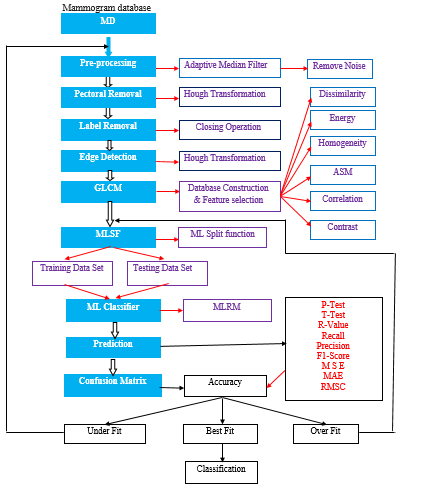Machine Learning Technique for Prediction of Breast Cancer
Main Article Content
Abstract
Breast cancer is one of the most prominent disease and the second foremost source of death among middle-aged women in the world. Removing of breast tumour by using a surgical treatment and chemotherapy could work excellently if it can be identified as a primary tumour or at an early stage of transmutation, however it is a costly process. The quick development of machine learning techniques continues to burn the medical tomography enthusiasm in implementing to improve the accurateness of tumour findings. To identify breast cancer in the area of machine learning lots of attempts were made, but these techniques are not too accurate. In the proposed Machine Learning Technique for Prediction of Breast Cancer (MLTPBC) is an automated system used to remove a label, pectoral muscles, noise, and identification of cancer. The experimental results of the proposed MLTPBC shows the preferable accuracy over the existing methods.
Article Details
References
Babymol Kurian, VL Jyothi, “Breast cancer prediction using an optimal machine learning technique for next generation sequences”. 2021, Vol. 29(1) 49–57.
Maleika Heenaye-Mamode Khan, Nazmeen Boodoo-Jahangeer, Wasiimah Dullull, Shaista Nathire, Xiaohong Gao, G. R. Sinha, Kapil Kumar Nagwanshi. “Multi- class classification of breast cancer abnormalities using Deep Convolutional Neural Network (CNN)”. August 26, 2021.
Mr. Dharmesh Dhabliya, Prof. Ojaswini Ghodkande. (2016). Prevention of Emulation Attack in Cognitive Radio Networks Using Integrated Authentication . International Journal of New Practices in Management and Engineering, 5(04), 06 - 11. Retrieved from http://ijnpme.org/index.php/IJNPME/article/view/48
Qingji Tian , Yongtang, Xiang Ren, Navid Razmjooy. “A New optimized sequential method for lung tumor diagnosis based on deep learning and converged search and rescue algorithm”. Biomedical Signal Processing and Control, Volume 68, July 2021, 102761.
Zhiqiang Guo, Lina Xu, Yujuan Si, Navid Razmjooy. “Novel computer-aided lung cancer detection based on convolutional neural network-based and feature-based classifiers using metaheuristics”. INTENATIONAL JOURNAL OF IMAGING SYSTEMS AND TECHNOLOGY, 05 June 2021.
Shen, L., Margolies, L.R., Rothstein, J.H. et al. “Deep Learning to Improve Breast Cancer Detection on Screening Mammography”. Sci Rep 9, 12495 (2019).
Elter, M. & Horsch, A. “CADx of mammographic masses and clustered microcalcifications: A review”. Med. Phys. 36, 2052–2068 (2009).
Fenton, J. J. et al. “Influence of Computer-Aided Detection on Performance of Screening Mammography”. New Engl. J. Medicine 356, 1399–1409 (2007).
Cole, E. B. et al. “Impact of Computer-Aided Detection Systems on Radiologist Accuracy With Digital Mammography”. Am. J. Roentgenol. 203, 909–916 (2014).
Drukteinis JS, Mooney BP, Flowers CI. et al. “Beyond mammography: new frontiers in breast cancer screening”. Am J Med. 2013;126: 472–479.
Jemal A., Bray F., Center M.M., Ferlay J., Ward E., Forman D. “Global Cancer Statistics”. A Cancer Journal for Clinicians, Vol. 61, No. 2, pp.69-90, 2011.
Martinez, M., Davies, C., Garcia, J., Castro, J., & Martinez, J. Machine Learning-Enabled Quality Control in Engineering Manufacturing. Kuwait Journal of Machine Learning, 1(2). Retrieved from http://kuwaitjournals.com/index.php/kjml/article/view/122
Lehman, C. D. et al.” Diagnostic Accuracy of Digital Screening Mammography With and Without Computer-Aided Detection”. JAMA Intern. Medicine 175, 1828–1837, 2015.
Lynch HT, Watson P, Conway TA. “Clinical genetic features in hereditary breast cancer. Breast Cancer Res Treat”. 1990; 15: 63–71.
Prevention CfDCa. Cancer screening - the United States, 2010. Morb Mortal Wkly Rep. 2012; 61: 41–45.
Oeffinger, K. C. et al.”Breast Cancer Screening for Women at Average Risk: 2015 Guideline Update From the American Cancer Society”. JAMA 314, 1599–1614 (2015).
Jemal A, Siegel R, Ward E, Hao Y, Xu J, Thun MJ. “Cancer statistics”. 2009. CA Cancer J Clin. 2009; 59: 225–249.
Heravi Karimovi M, Pourdehqan M, Jadid Milani M, Foroutan SK, Aieen F. “Study of the effects of group counseling on quality of sexual life of patients with breast cancer under chemotherapy at Imam Khomeini Hospital”. J Mazandaran Univ Med Sci. 2006; 16(54): 43–51.
Mryka Hall-Beyer (2008, August 29) “The GLCM texture tutorial”.
Litjens G, Kooi T, Bejnordi BE, et al. “A survey on deep learning in medical image analysis”. Med Image Anal 2017; 42: 60–88.
Kooi T, Litjens G, van Ginneken B, et al.”Large scale deep learning for computer-aided detection of mammographic lesions”. Med Image Anal 2017; 35: 303–312.
Jinshan Tang , Rangaraj M. Rangayyan, Issam El Naqa, and Yongyi Yang. “Computer-Aided Detection and Diagnosis of Breast Cancer With Mammography: Recent Advances”. IEEE TRANSACTIONS ON INFORMATION TECHNOLOGY IN BIOMEDICINE, VOL. 13, NO. 2, MARCH 2009.
Mitra Montazeria,b, Mohadeseh Montazeric,d, Mahdieh Montazerie, and Amin Beigzadehf. “Machine learning models in breast cancer survival prediction”. Technology and Health Care 24 (2016) 31–42.
C Naga Raju, A Hima Bindhu. “Primary Screening Technique for Detecting Breast Cancer”. i-manager's Journal on Image Processing, Volume 6, Issue 2, April 2019.
C Naga Raju, A Hima Bindhu.” Removal of Pectoral Muscles and Locating Cancer in Breast using Fuzzy Technique”. i-manager’s Journal on Image Processing, Volume5, Issue 4, pages17-25, Dec ember 2018.
C Naga Raju, C Harikiran, T Siva Priya. “Design of primary screening tool for early detection of breast cancer”. Journal of Advances in Information Technology, Volume 3, Issue 4,228-235, November 2012.

